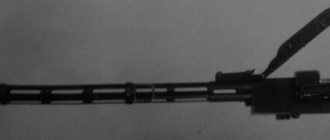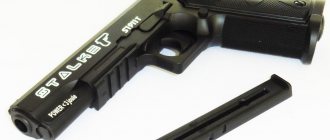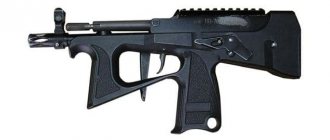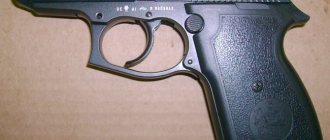Submachine gun "Vityaz" and "Vityaz-CH"
In the early 1990s, interest in submachine guns revived in Russia. This interest became the basis for the emergence of a new branch of the unified “Kalashnikov family” and its development at the beginning of the 21st century.
The main “consumers” of submachine guns at the new stage were armed forces of law enforcement agencies.
FROM “BIZON” TO “VITYAZ”
The first submachine gun, commissioned by the Ministry of Internal Affairs of the Russian Federation, was the PP-19 “Bison-2” submachine gun chambered for 9 x 18 PM with an original auger magazine and the unification of a number of parts and components with AKS74U and AK74M assault rifles. Soon the Bison-2 became the basis for its own “family” of submachine guns.
The experience of testing the Bizon-2 submachine guns in production at the Izhevsk Machine-Building Plant and its use in special-purpose units of law enforcement agencies made it possible to develop a new model with a box magazine that is easier to load and quicker to replace. Since 2003, in accordance with the issued tactical and technical specifications, the development of a model for 9x19 cartridges has been underway. The theme was called “Vityaz”.
It is worth remembering that the 9 x 19 type cartridge appeared in the domestic arsenal as a result of development work on new combat pistol systems. With the appropriate bullet design, the 9 x 19 pistol cartridge is better than the 9 x 18 cartridge in meeting the requirements of combating living targets protected by personal armor (PIB) located in vehicles behind light cover. Hence, its best compliance with the purpose of the submachine gun as a weapon for special forces. The development of submachine guns chambered for the 9 x 19 cartridge was carried out in parallel with the development of domestic versions of this cartridge.
Read: Promising Russian fighter T-50 (PAK FA)
The design of the 9 mm Vityaz turned out to be at least 70% unified with the serial AK74M assault rifle and the Bizon-2 submachine gun, which facilitated the organization of its mass production and operation. The new type of weapon received the index PP-19-01. Later, the “Vityaz SN” (“Vityaz-Spetsnaz”) version appeared, unified in parts and components with the “hundredth” series AK assault rifles already in mass production. By decree of the Government of the Russian Federation of June 24, 2005, the Vityaz-SN submachine gun was adopted by the Ministry of Internal Affairs of the Russian Federation.
WEAPONS AND AMMO
While maintaining many of the “family” features of the Kalashnikov system, the Vityaz-CH (as, indeed, the Bison-2) has a number of significant differences. First of all, weapon automation works by using the recoil energy of a free shutter. The shutter has no rotating parts. The valve stem only houses the return spring and does not carry the piston. At the same time, a relatively large bolt stroke (allowed by the dimensions of the receiver) and a return spring with a large number of turns made it possible to soften the effect of recoil on the weapon and the shooter, reduce the rate of fire and improve its accuracy. Together with the reduction in weight, this made it easier to control the weapon when firing. The reloading handle is rigidly connected to the bolt; its shape and dimensions are designed for work in the field, wearing thick gloves. The hammer-type trigger mechanism allows for single and automatic fire, and is similar in design and operation to a basic machine gun. Firing with the shutter closed (“from the front sear”) promotes shooting accuracy.
Read: Self-propelled artillery mount 2S35 “Coalition-SV”
The fastening of a detachable double-row box magazine of a sector shape in the Vityaz and Vityaz-SN is reinforced with a neck. To speed up their change, magazines can be connected two at a time with a special clip. The magazine can be loaded with 15-round clips. For shooting, you can use 9 x 19 cartridges of foreign and domestic production - in particular, the 7N21 cartridge with a bullet of increased penetration and the 7N31 with an armor-piercing bullet.
The pistol grip, fore-end and barrel guard are made of impact-resistant plastic. The left-folding frame metal stock is similar to the AKS74U assault rifle or the PP-19 submachine gun.
A slotted flame arrester is attached to the muzzle of the barrel, which can be replaced with a silencer (silent and flameless firing device, PBS). When firing cartridges with a bullet speed higher, the sound silencer plays the role of a low-noise shooting device, also eliminating the flash of flame when fired. The mechanical sighting device includes a front sight and a sector sight.
To install optical, collimator or night sights, you can use the rail on the left side of the receiver or the Picatinny rail on the receiver cover. The cover itself is attached to the receiver on a hinge, which, in fact, made it possible to use it for mounting sights. A flashlight, a laser target designator, and a front holding handle can be attached to the Picatinny rails on the forend. Unified Picatinny rails are widely used in modern hand-held small arms. Since special units of the Ministry of Internal Affairs use a wide range of sighting and auxiliary devices, installing such rails on a submachine gun does not look superfluous.
Read: Pistol "Tokejipt"
SELF-LOADING OPTION
Based on the Vityaz, a self-loading carbine IZH-9 x 19 was also developed for the same pistol cartridge. Its firing mechanism allows only single fire. The IZH-9 x 19 magazine is similar in size and shape to the Vityaz, but its capacity is limited by a special insert to ten rounds in accordance with legal requirements for weapons for the “civilian” market.
You might be interested:
- Submachine gun PP-91 “Kedr” and its modifications
- MP 18 submachine gun
- Pistol GSh-18
- The Serdyukov pistol is the most powerful among combat pistols
- Pistols and revolvers before the Second World War
- PM pistol (Makarov) - reliable, durable, compact
Subscribe to
our channel in Yandex.Zen
Specifications
The blade of this type of weapon has an anti-reflective coating in gray or camouflage colors. To prevent the hand from slipping, there is a guard on the instrument. The stops of the cross are turned towards the blade.
Knife “Vityaz” NSN and a cover for it.
For the handle, pressed leather or heat-resistant plastic is used. The presence of a metal pommel allows the weapon to be used as a glass breaker. The pommel has a hole for attaching a lanyard. The set includes a high quality leather sheath. The combat model has the following characteristics:
- the total length of the combat knife is 30.5 cm;
- blade length is 18 cm;
- maximum blade width is 2.8 cm;
- The maximum thickness at the butt is 0.5 cm.
Air defense system breakthrough
At the end of September, the Russian Ministry of Defense published footage of the flight of the fifth-generation fighter Su-57 and the prototype of the S-70 Okhotnik heavy reconnaissance and strike UAV. According to the military department, the plane and drone were practicing targeting the target without entering the enemy’s air defense coverage area.
“Hunter” is the brainchild of the Experimental Design Bureau P.O. Sukhoi. The device is made using radar stealth technology and is equipped with a single-engine power plant, which is unconventional for the Russian aircraft building school.
Flight tests of the S-70 began in August at the 929th State Flight Test Center named after Chkalov (GLITs, Akhtubinsk). According to a TASS source in the defense industry, in 2020 the drone will begin using strike weapons at the GLITs training ground. Experts believe that the device can use standard aviation ammunition of the VKS.
Honored Pilot of the Russian Federation, Major General Vladimir Popov, in a conversation with RT, said that the “Okhotnik” is being created to solve problems of breaking through even the most high-tech air defense system. According to him, the domestic military is developing tactics for using an aviation unit consisting of two Su-57s and three S-70 reconnaissance and attack UAVs.
“Most likely, the Okhotnik itself will become the carrier of several small-sized drones. A cluster of drones will increase the load on the computing power of the air defense complex. The system will have difficulties choosing targets to hit, because it is not able to fire at all objects at the same time,” Popov explained.
At the same time, the Honored Pilot of Russia, engineers and military personnel still have a lot of work to do. The amount of work is large; serial production of the UAV will not be launched until 2025.
"The rocket will be invulnerable"
One of the most closed projects of the Russian defense industry is the 3M22 Zircon hypersonic missile. However, on February 20, the veil of secrecy was slightly lifted by Russian President Vladimir Putin in his message to the Federal Assembly. He said that the flight speed of the ammunition will be Mach 9, the range will be over 1 thousand km. The missile will be able to destroy both sea and ground targets.
From official information it follows that the Zircon in various modifications will be included in the arsenal of corvettes and frigates of the Navy, equipped with a universal ship-based firing system (UKSK). Hypersonic missiles will also be able to launch new destroyers, landing ships, modernized cruisers, large anti-submarine ships and multi-purpose nuclear submarines.
- Launch of a Navy missile in the Caspian Sea
Vladimir Putin calls Zircon an extremely important weapon “for maintaining strategic stability.” In addition to the naval version of the hypersonic munition, experts believe, Russia can also develop a ground modification.
The creation of a land-based Zircon will be a response to the appearance of previously prohibited weapons in the US arsenal after the termination of the Intermediate-Range Nuclear Forces Treaty (INF Treaty), analysts say.
Naval unification
Together with the S-350 Vityaz, the designers of the Almaz-Antey concern developed the latest shipborne air defense system Poliment-Redut. Both systems are unified, which implies the production of the same type of structural elements, components, assemblies, systems, launchers and ammunition that are equipped with various weapons systems. Military experts note that this approach allows saving significant funds on organizing serial production, as well as improving the operational characteristics of air defense systems.
"Poliment-Redut" is designed to protect Navy destroyers, frigates and corvettes from air attack. Currently, Poliment-Redut is installed on the frigate Admiral Gorshkov and the corvette Soobrazitelny.
Also on topic
"Lotus", "Vityaz" and the Arctic "Thor": what new products were presented at the international forum "Army-2019"
The international military-technical forum “Army-2019” has begun in the Moscow region. The total exhibition area is about 165 thousand square meters...
The complex is capable of hitting enemy aircraft, cruise and anti-ship missiles at a range of up to 150 km. The Poliment-Redut maritime complex is equipped with 9M100, 9M96 and 9M96D missiles.
In addition, the developers of the complex state that in the coming years a new ultra-long-range anti-aircraft guided missile based on 40N6 ammunition for the S-400 and S-500 systems will be developed for unified air defense systems. This new projectile will allow the air defense system to intercept air targets at a distance of up to 400 km.
The S-350 complex, just like its predecessor the S-300, has no analogues abroad, retired colonel Viktor Litovkin emphasized in a conversation with RT.
“Of course, Vityaz will strengthen Russia’s defense capabilities. Moscow already has a more powerful S-400 complex, and the newest S-500 complex will soon be put into service. But the S-350 is one of the elements of the system, one of the frontiers of air defense,” the expert explained.
In addition, it can be assumed that the Vityaz will become a successful export model, especially for countries that cannot afford other types of Russian air defense.
This assessment of the S-350 is shared by Yuri Knutov, who suggested that export modifications of the Vityaz could be presented at the parade on the occasion of the 75th anniversary of the victory in the Great Patriotic War.
“The complex will definitely become an export product in the future. There is an export version of it, the S-350E Vityaz, which may be shown at the parade in honor of May 9 in 2020,” the expert concluded.
Incomplete disassembly
To keep the weapon in excellent condition, regular maintenance is required: cleaning and lubricating parts, checking the serviceability of technical components. To do this, you need to know how partial disassembly is carried out:
- By pressing the magazine latch, remove it;
- Switch the safety to single shot mode;
- Cock the trigger - move the bolt to the rearmost position. At this stage, the chamber is checked (there should be no ammunition in it);
- Disconnect the butt - grab it firmly with your hand and make a sharp movement back;
- The plunger flag is moved to a vertical state in the forend of the handle;
- Move the receiver and bolt back to disconnect it from the handle;
- Remove the butt plate - press the rod with the thumb of your working hand;
- Remove the return mechanism;
- Disconnect the bolt and receiver.
Podolsky "Lotus"
On June 5, TsNIITOCHMASH JSC (Podolsk) held a presentation for journalists of a prototype of the 120-mm airborne self-propelled artillery gun (SAO) 2S42 “Lotos”. The new complex replaced the 2S9 “Nona” installation, which has been in service with the Airborne Forces and Marine Corps since the 1980s. The chief designer of the new self-propelled joint stock company is Veniamin Schastlivtsev.
"Lotos" significantly surpasses its predecessor in all tactical and technical characteristics. The firing range of the 2S42 with standard ammunition is 13 km (versus 8.8 km for the Nona). Schastlivtsev is confident that this figure can be increased to 20 km if the defense industry creates new glide munitions.
A number of engineering solutions contributed to the increase in destruction range. In particular, TsNIITOCHMASH specialists lengthened the barrel of the self-propelled gun by two meters (up to 5 m versus 3 m for the Nona) and equipped the vehicle with a remote fire control system
An important innovation was the ability to receive target designation from external sources, including drones
"Lotos", whose security is much higher than that of "Nona", is made on the BMD-4M chassis. The self-propelled guns are equipped with new armor and an active protection complex, which allows them to intercept enemy artillery ammunition and destroy the source of the threat.
“In particular, we solved the problem of protecting the self-propelled guns from high-precision weapons. The gun is equipped with a corresponding complex, which includes laser irradiation indicators. We fix the direction from which the attack is being launched, and the launchers are aimed almost synchronously. The target is destroyed by special aerosol-forming ammunition (AOB-5),” explained Schastlivtsev.










